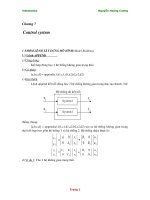Terminology.doc
Bạn đang xem bản rút gọn của tài liệu. Xem và tải ngay bản đầy đủ của tài liệu tại đây (17.1 KB, 5 trang )
Application Server (AS) - A logical entity serving a specific Routing
Key. An example of an Application Server is a virtual switch element
handling all call processing for a unique range of PSTN trunks,
identified by an SS7 SIO/DPC/OPC/CIC_range. Another example is a
virtual database element, handling all HLR transactions for a
particular SS7 DPC/OPC/SCCP_SSN combination. The AS contains a set
of one or more unique Application Server Processes, of which one or
more is normally actively processing traffic. Note that there is a
1:1 relationship between an AS and a Routing Key.
Application Server Process (ASP) - A process instance of an
Application Server. An Application Server Process serves as an active
or backup process of an Application Server (e.g., part of a
distributed virtual switch or database). Examples of ASPs are
processes (or process instances) of MGCs, IP SCPs or IP HLRs. An ASP
contains an SCTP endpoint and may be configured to process signalling
traffic within more than one Application Server.
Association - An association refers to an SCTP association. The
association provides the transport for the delivery of MTP3-User
protocol data units and M3UA adaptation layer peer messages.
IP Server Process (IPSP) - A process instance of an IP-based
application. An IPSP is essentially the same as an ASP, except that
it uses M3UA in a point-to-point fashion. Conceptually, an IPSP does
not use the services of a Signalling Gateway node.
Failover - The capability to reroute signalling traffic as required
to an alternate Application Server Process, or group of ASPs, within
an Application Server in the event of failure or unavailability of a
currently used Application Server Process. Failover also applies
upon the return to service of a previously unavailable Application
Server Process.
Host - The computing platform that the process (SGP, ASP or IPSP) is
running on.
Layer Management - Layer Management is a nodal function that handles
the inputs and outputs between the M3UA layer and a local management
entity.
Linkset - A number of signalling links that directly interconnect two
signalling points, which are used as a module.
MTP - The Message Transfer Part of the SS7 protocol.
MTP3 - MTP Level 3, the signalling network layer of SS7
MTP3-User - Any protocol normally using the services of the SS7 MTP3
(e.g., ISUP, SCCP, TUP, etc.).
Network Appearance - The Network Appearance is a M3UA local reference
shared by SG and AS (typically an integer) that together with an
Signaling Point Code uniquely identifies an SS7 node by indicating
the specific SS7 network it belongs to. It can be used to distinguish
between signalling traffic associated with different networks being
sent between the SG and the ASP over a common SCTP association. An
example scenario is where an SG appears as an element in multiple
separate national SS7 networks and the same Signaling Point Code
value may be reused in different networks.
Network Byte Order: Most significant byte first, a.k.a Big Endian.
Routing Key: A Routing Key describes a set of SS7 parameters and
parameter values that uniquely define the range of signalling traffic
to be handled by a particular Application Server. Parameters within
the Routing Key cannot extend across more than a single Signalling
Point Management Cluster.
Routing Context - A value that uniquely identifies a Routing Key.
Routing Context values are either configured using a configuration
management interface, or by using the routing key management
procedures defined in this document.
Signalling Gateway Process (SGP) - A process instance of a Signalling
Gateway. It serves as an active, backup, load-sharing or broadcast
1
process of a Signalling Gateway.
Signalling Gateway - An SG is a signaling agent that receives/sends
SCN native signaling at the edge of the IP network [11]. An SG
appears to the SS7 network as an SS7 Signalling Point. An SG
contains a set of one or more unique Signalling Gateway Processes, of
which one or more is normally actively processing traffic. Where an
SG contains more than one SGP, the SG is a logical entity and the
contained SGPs are assumed to be coordinated into a single management
view to the SS7 network and to the supported Application Servers.
Signalling Process - A process instance that uses M3UA to communicate
with other signalling processes. An ASP, an SGP and an IPSP are all
signalling processes.
Signalling Point Management Cluster (SPMC) - The complete set of
Application Servers represented to the SS7 network under a single MTP
entity (Signalling Point) in one specific Network Appearance. SPMCs
are used to aggregate the availability, congestion, and user part
status of an MTP entity (Signalling Point) that is distributed in the
IP domain, for the purpose of supporting MTP3 management procedures
towards the SS7 network. In some cases, the SG itself may also be a
member of the SPMC. In this case, the SG availability /congestion
/User_Part status should also be taken into account when considering
any supporting MTP3 management actions.
Stream - A stream refers to an SCTP stream; a unidirectional logical
channel established from one SCTP endpoint to another associated SCTP
endpoint, within which all user messages are delivered in-sequence
except for those submitted to the unordered delivery service.
Active destination transport address: A transport address on a
peer endpoint which a transmitting endpoint considers available
for receiving user messages.
Bundling: An optional multiplexing operation, whereby more than
one user message may be carried in the same SCTP packet. Each
user message occupies its own DATA chunk.
Chunk: A unit of information within an SCTP packet, consisting of
a chunk header and chunk-specific content.
Congestion Window (cwnd): An SCTP variable that limits the data,
in number of bytes, a sender can send to a particular destination
transport address before receiving an acknowledgement.
Cumulative TSN Ack Point: The TSN of the last DATA chunk
acknowledged via the Cumulative TSN Ack field of a SACK.
Idle destination address: An address that has not had user
messages sent to it within some length of time, normally the
HEARTBEAT interval or greater.
Inactive destination transport address: An address which is
considered inactive due to errors and unavailable to transport
user messages.
Message = user message: Data submitted to SCTP by the Upper Layer
Protocol (ULP).
Message Authentication Code (MAC): An integrity check mechanism
based on cryptographic hash functions using a secret key.
Typically, message authentication codes are used between two
parties that share a secret key in order to validate information
transmitted between these parties. In SCTP it is used by an
endpoint to validate the State Cookie information that is returned
from the peer in the COOKIE ECHO chunk. The term "MAC" has
different meanings in different contexts. SCTP uses this term
with the same meaning as in [RFC2104].
Network Byte Order: Most significant byte first, a.k.a., Big
Endian.
Ordered Message: A user message that is delivered in order with
respect to all previous user messages sent within the stream the
message was sent on.
2
Outstanding TSN (at an SCTP endpoint): A TSN (and the associated
DATA chunk) that has been sent by the endpoint but for which it
has not yet received an acknowledgement.
Path: The route taken by the SCTP packets sent by one SCTP
endpoint to a specific destination transport address of its peer
SCTP endpoint. Sending to different destination transport
addresses does not necessarily guarantee getting separate paths.
Primary Path: The primary path is the destination and source
address that will be put into a packet outbound to the peer
endpoint by default. The definition includes the source address
since an implementation MAY wish to specify both destination and
source address to better control the return path taken by reply
chunks and on which interface the packet is transmitted when the
data sender is multi-homed.
Receiver Window (rwnd): An SCTP variable a data sender uses to
store the most recently calculated receiver window of its peer, in
number of bytes. This gives the sender an indication of the space
available in the receiver’s inbound buffer.
SCTP association: A protocol relationship between SCTP endpoints,
composed of the two SCTP endpoints and protocol state information
including Verification Tags and the currently active set of
Transmission Sequence Numbers (TSNs), etc. An association can be
uniquely identified by the transport addresses used by the
endpoints in the association. Two SCTP endpoints MUST NOT have
more than one SCTP association between them at any given time.
SCTP endpoint: The logical sender/receiver of SCTP packets. On a
multi-homed host, an SCTP endpoint is represented to its peers as
a combination of a set of eligible destination transport addresses
to which SCTP packets can be sent and a set of eligible source
transport addresses from which SCTP packets can be received. All
transport addresses used by an SCTP endpoint must use the same
port number, but can use multiple IP addresses. A transport
address used by an SCTP endpoint must not be used by another SCTP
endpoint. In other words, a transport address is unique to an
SCTP endpoint.
SCTP packet (or packet): The unit of data delivery across the
interface between SCTP and the connectionless packet network
(e.g., IP). An SCTP packet includes the common SCTP header,
possible SCTP control chunks, and user data encapsulated within
SCTP DATA chunks.
SCTP user application (SCTP user): The logical higher-layer
application entity which uses the services of SCTP, also called
the Upper-layer Protocol (ULP).
Slow Start Threshold (ssthresh): An SCTP variable. This is the
threshold which the endpoint will use to determine whether to
perform slow start or congestion avoidance on a particular
destination transport address. Ssthresh is in number of bytes.
Stream: A uni-directional logical channel established from one to
another associated SCTP endpoint, within which all user messages
are delivered in sequence except for those submitted to the
unordered delivery service.
Note: The relationship between stream numbers in opposite directions
is strictly a matter of how the applications use them. It is the
responsibility of the SCTP user to create and manage these
correlations if they are so desired.
Stream Sequence Number: A 16-bit sequence number used internally
by SCTP to assure sequenced delivery of the user messages within a
given stream. One stream sequence number is attached to each user
message.
Tie-Tags: Verification Tags from a previous association. These
Tags are used within a State Cookie so that the newly restarting
3
association can be linked to the original association within the
endpoint that did not restart.
Transmission Control Block (TCB): An internal data structure
created by an SCTP endpoint for each of its existing SCTP
associations to other SCTP endpoints. TCB contains all the status
and operational information for the endpoint to maintain and
manage the corresponding association.
Transmission Sequence Number (TSN): A 32-bit sequence number used
internally by SCTP. One TSN is attached to each chunk containing
user data to permit the receiving SCTP endpoint to acknowledge its
receipt and detect duplicate deliveries.
Transport address: A Transport Address is traditionally defined
by Network Layer address, Transport Layer protocol and Transport
Layer port number. In the case of SCTP running over IP, a
transport address is defined by the combination of an IP address
and an SCTP port number (where SCTP is the Transport protocol).
Unacknowledged TSN (at an SCTP endpoint): A TSN (and the associated
DATA chunk) which has been received by the endpoint but for which
an acknowledgement has not yet been sent. Or in the opposite case,
for a packet that has been sent but no acknowledgement has been
received.
Unordered Message: Unordered messages are "unordered" with respect
to any other message, this includes both other unordered messages
as well as other ordered messages. Unordered message might be
delivered prior to or later than ordered messages sent on the same
stream.
User message: The unit of data delivery across the interface
between SCTP and its user.
Verification Tag: A 32 bit unsigned integer that is randomly
generated. The Verification Tag provides a key that allows a
receiver to verify that the SCTP packet belongs to the current
association and is not an old or stale packet from a previous
association.
Backhaul:
Backhaul refers to the transport of signaling from the point of
interface for the associated data stream (i.e., SG function in the
MGU) back to the point of call processing (i.e., the MGCU), if this
is not local.
Signaling Transport (SIG):
SIG refers to a protocol stack for transport of SCN signaling
protocols over an IP network. It will support standard primitives to
interface with an unmodified SCN signaling application being
transported, and supplements a standard IP transport protocol
underneath with functions designed to meet transport requirements for
SCN signaling.
Switched Circuit Network (SCN):
The term SCN is used to refer to a network that carries traffic
within channelized bearers of pre-defined sizes. Examples include
Public Switched Telephone Networks (PSTNs) and Public Land Mobile
Networks (PLMNs). Examples of signaling protocols used in SCN
include Q.931, SS7 MTP Level 3 and SS7 Application/User parts.
The following are terms for functional entities relating to signaling
transport in a distributed gateway model.
Media Gateway (MG):
A MG terminates SCN media streams, packetizes the media data,, if it
is not already packetized, and delivers packetized traffic to the
packet network. It performs these functions in reverse order for
media streams flowing from the packet network to the SCN.
Media Gateway Controller (MGC):
An MGC handles the registration and management of resources at the
MG. The MGC may have the ability to authorize resource usage based on
4
local policy. For signaling transport purposes, the MGC serves as a
possible termination and origination point for SCN application
protocols, such as SS7 ISDN User Part and Q.931/DSS1.
Signaling Gateway (SG):
An SG is a signaling agent that receives/sends SCN native signaling
at the edge of the IP network. The SG function may relay, translate
or terminate SS7 signaling in an SS7-Internet Gateway. The SG
function may also be co-resident with the MG function to process SCN
signaling associated with line or trunk terminations controlled by
the MG (e.g., signaling backhaul).
The following are terms for physical entities relating to signaling
transport in a distributed gateway model:
Media Gateway Unit (MGU)
An MG-Unit is a physical entity that contains the MG function. It
may contain other functions, esp. an SG function for handling
facility-associated signaling.
Media Gateway Control Unit (MGCU)
An MGC-Unit is a physical entity containing the MGC function.
Signaling Gateway Unit (SGU)
An SG-Unit is a physical entity containing the SG function.
Signaling End Point (SEP):
This is a node in an SS7 network that originates or terminates
signaling messages. One example is a central office switch.
Signal Transfer Point (STP):
This is a node in an SS7 network that routes signaling messages based
on their destination point code in the SS7 network.
5






